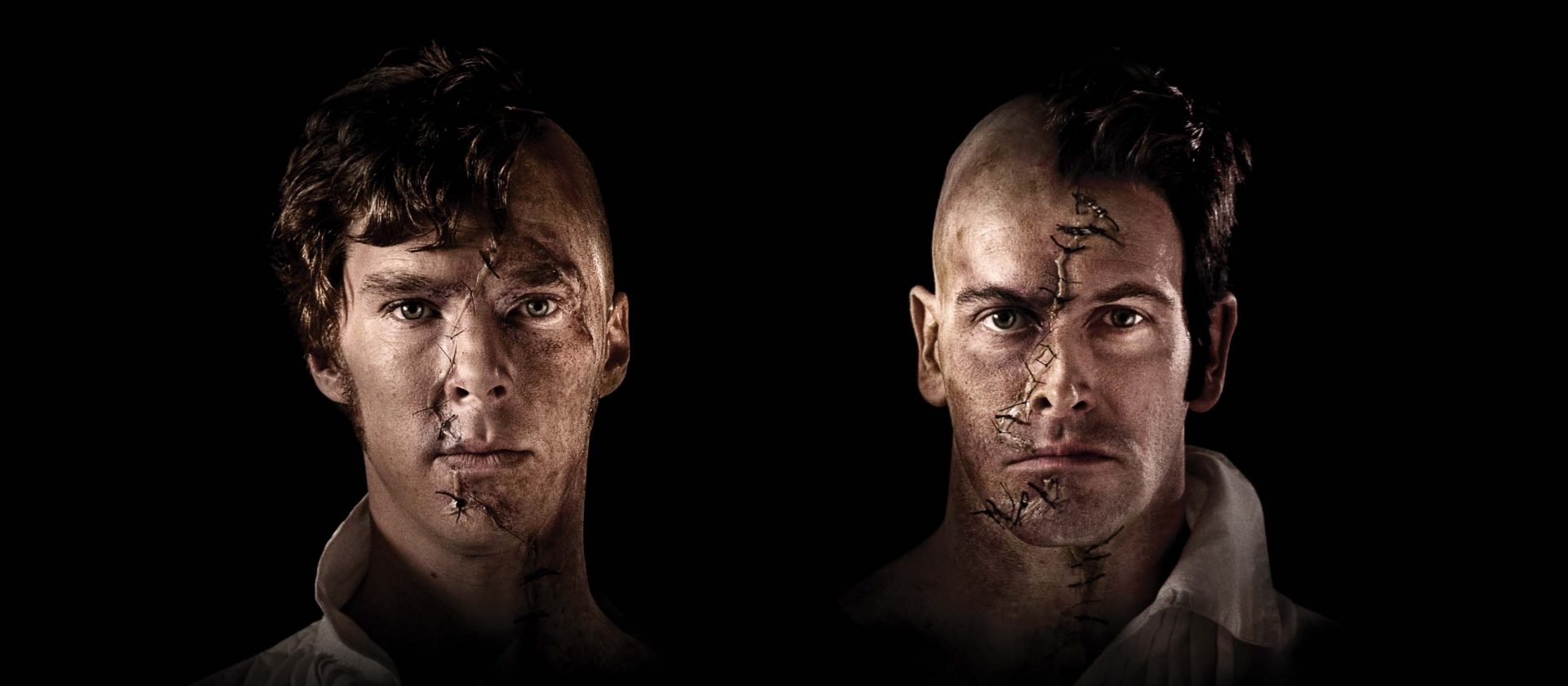They say that knowledge is knowing Frankenstein and the monster are different characters, but wisdom is knowing they are the same. National Theatre’s celebrated 2011 production conveyed this idea almost literally by having the two lead actors, Benedict Cumberbatch and Jonny Lee Miller, take on both roles and perform them on alternating nights. Both versions are now available to watch on National Theatre Live’s YouTube channel, and, even when divested of the broader sensory experience of theatre, the production still makes for enthralling viewing. This review focuses on the version with Cumberbatch as Victor Frankenstein and Miller as the Creature.
The performance begins with a protracted ‘birth’ scene, which serves to reinvent for the audience a moment that they might expect to find familiar from previous incarnations of the story on stage and screen. This coming to life could not be further from the famous, revelatory laboratory scene from the 1931 James Whale film. There is no “It’s ALIIIVE!” eureka moment as Victor Frankenstein watches his creation stir into life. Instead, this is a lonely and agonising birth, with Miller bursting forth from a womb-like structure onto a forbiddingly stark, red-lit stage, met by only a foreboding drum beat. His contorted movements and anguished guttural noises are confrontingly visceral, making the performance both powerful and deeply unsettling to watch. Audience unease is furthered by the grotesque work of makeup artist Jan Sewell.
Throughout, writer Nick Dear and director Danny Boyle clearly relish the audience’s discomfort, hoping to reignite the sense of horror that permeates Mary Shelley’s 1818 novel. Shelley’s genuine horror, of course, does not relate to the Creature himself. Rather, she directed it towards the various social and political injustices that existed in a world she perceived as controlled by privileged men who were compounding their own power through their overzealous elevation of science, to the detriment of moral and philosophical considerations – and, of course, the arts. At many points, Boyle communicates these complex anxieties with stunning economy. An early scene involving a steam train rolling ominously forward across the stage and a temporary steampunk aesthetic captures a sense of the dystopian threat that must’ve accompanied rapid technological advancement amidst the Industrial Revolution.
There are other inspired nods to Shelley’s influences: some striking pyrotechnics allude to the novel’s subtitle, ‘The Modern Prometheus’, and the lighting design by Bruno Poet seems, at times, to be suggestive of the volcanic eruption that caused The Year Without a Summer, which occurred the same year Shelley wrote the novel. Shelley’s feminism, influenced by her mother, Mary Wollstonecraft, is expressed via the character of Elizabeth (Noemie Harris), Victor’s fiancée, who provides a moral centre, and acts as a foil to highlight his arrogance and single-mindedness. Such elements contribute to the richness and complexity of the production.
Cumberbatch is suitably convincing as the eccentric Victor Frankenstein, switching in rapid turns between impassive disinterest in pressing familial or romantic concerns, horrified rejection of the creature he brought to life, and perverse titillation when confronted by evidence of his own scientific abilities. Like Miller and Harris, he manages to achieve this with a subtlety not directly offered by a script that is occasionally a little laborious and heavy handed in its signposting of key themes and messages.
One such theme is the various parallels and symbiosis that exists between Victor and the Creature, explored at length in the play’s emotional final scenes. Victor, interested only in reducing all of life into a mathematical equation, and the Creature, corrupted, but desperate to experience love, and whose understanding of humanity is influenced solely by poetry and music, are ultimately defeated by their obsession with each other, yet it is this obsession that drives them both forward. Neither character is remotely heroic, especially the Creature whose brutality -particularly in this production- precludes any sentimentality towards him (although notably the graphic brutality has been edited to comply with YouTube’s terms and conditions, but the allusion remains).
It remains true that during this time of great uncertainty, when the Covid-19 pandemic is causing theatre closures across the world and presenting arts industries with such profound threat, Frankensein’s reminder of the essential role of the arts in our own collective understanding of what it is to be human feels decidedly timely and poignant.
Frankenstein can be streamed on YouTube until 8th May here.


Comments